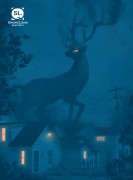This story draws from the mythology of selkies, which are half-seal, half-human creatures. Did you start with the mythology as your inspiration, or was something else the catalyst for this piece?
The first three lines sprung up together, and I was struck by this selkie who was afraid to go back in the ocean, which was very unlike the myth. Selkies are usually portrayed as women who can transform into seals as long as they still possess their pelts—pelts that their husbands are cautioned to hide so as to keep them from taking their children and returning to the sea. At the heart of the myth is men fearing what women are capable of—which is certainly an issue relevant today—but I wanted a woman and her needs to be at the center of this piece. While it doesn’t quite pass the Bechdel test, I wanted to write a story with a character afraid of what she herself is capable of and a daughter who is frustrated with her for not pursuing it. It was only in later drafts when I realized that the daughter had to embrace her own identity before the mother could rediscover hers.
What was most challenging and rewarding about retelling a myth?
In the mythology of selkies, husbands are depicted as victims of betrayal, but I wanted to bypass that and still retain the element of uncertainty inherent to this particular shape-shifting figure. The mother’s struggle both simultaneously connects her to and distances her from her children, and I tried to balance the humanity of this with the wild nature of the seal by having the daughter take her own identity to a violent extreme. I always wondered what the kids of selkies thought of the whole thing. Did they want to return to the ocean, or would they have preferred to live as humans? Were they angry at having to choose? Or not being able to? Did they witness their mothers grieve the choices they’d made? Did they grow up to make similar choices? I wanted to bridge the gap between myth and reality by getting at questions people in the here and now might ask themselves.
The tension between mother and daughter drives this narrative, and I interpreted it as a story about the mother’s struggle with her identity after losing her husband. What are the advantages of telling this story from a fantastical perspective?
I think the mother’s struggle with identity depends more on her relationship with her grownup children, only one of whom recognizes that her mother has focused on others for so long that she’s uncertain of where she belongs. I think characters who are fantastical beings ask both writer and reader to look at what it really means to be human. If a character is too alien in their needs and wants, they won’t be someone a reader can relate to. But by playing with metaphor, a writer can poke at truths that are difficult to reveal (or face) because they typically camouflage themselves in familiarity.
I love the imagery and lyricism in phrases you use like “Her long teeth hollowed it and made its spine a necklace.” Have any poets influenced your work?
Yes! I came to writing through poetry and spoken word, and there are so many, many poets who have influenced me, particularly women, feminist, and/or queer poets writing cathartic, autobiographical poems. Sylvia Plath, Adrienne Rich, Nikki Giovanni, and Ada Limón are a few. Donika Kelly is a recent favorite. I love Bestiary and how she uses animals both real and mythical to confront her own monsters.
The story ends with a figurative and literal cliffhanger. Can you tell us a little about your choice to end the story with that moment of indecision?
It is definitely a moment of indecision, and it’s the kind of indecision where the tough choice is the right one. I really like writing about indecision and risk taking, and that’s probably something about myself that leaks onto the page. (I nearly added “Maybe not” and then changed my mind, if that tells you anything!) In many ways this story is also about the role reversal of a parent and child, specifically supporting a parent taking a risk when they are usually the one supporting you. That is a strange and terrifying place to be. Flash fiction is a great form for writing about big moments because the nature of flash is to be vaster than the space it takes on the page.



 The core workshop of SmokeLong Fitness is all in writing, so you can take part from anywhere at anytime. We are excited about creating a supportive, consistent and structured environment for flash writers to work on their craft in a community. We are thrilled and proud to say that our workshop participants have won, placed, or been listed in every major flash competition. Community works.
The core workshop of SmokeLong Fitness is all in writing, so you can take part from anywhere at anytime. We are excited about creating a supportive, consistent and structured environment for flash writers to work on their craft in a community. We are thrilled and proud to say that our workshop participants have won, placed, or been listed in every major flash competition. Community works.